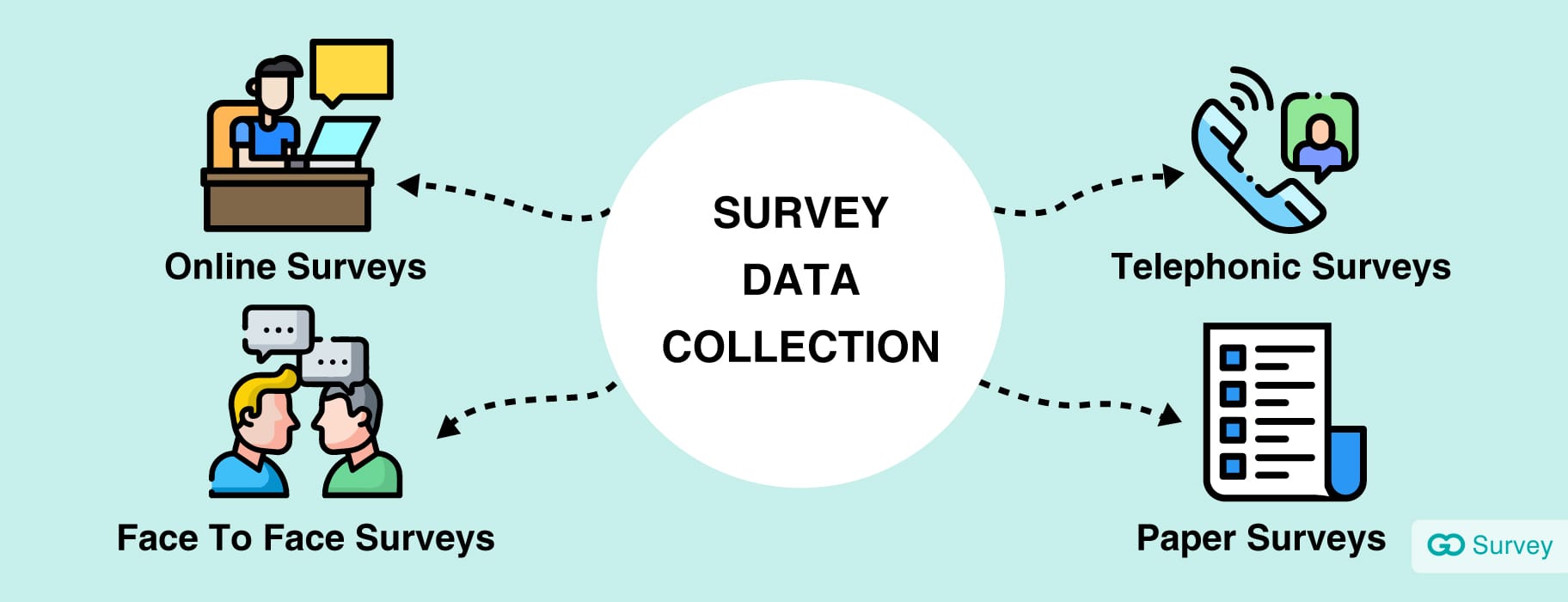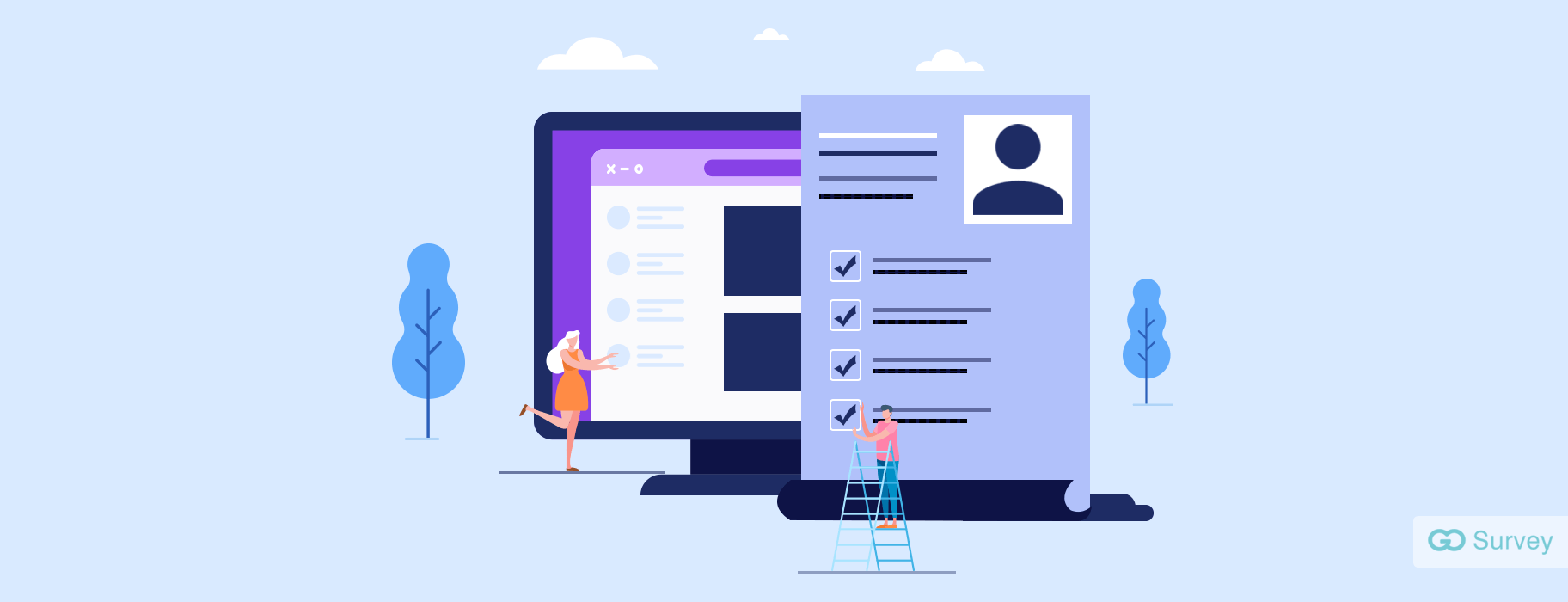Who hasn’t hassled around surveys? Schools, census, restaurants, hospitals— surveys have been a vital part of our lives everywhere— whether we like them or not.
From traditional paper-based offline surveys to web-based digital questionnaires— they... have... always... been... around, simply coming out in different forms depending on the resources at our disposal.
But online surveys have taken the survey research to the next level.
What would you have? A survey form that reaches thousands in a few seconds & at a relatively low cost, or the one that reaches a few hundred in hours or sometimes, even days? Most of us will choose option A.
That’s what online surveys bring to the table. Flexibility, customization, speed, and budget! You can send over your surveys to thousands of chosen respondents in a single tap, customize your designs to add visual flairs, & the most important of all— deploy your questionnaire in a jiffy without having to dig your pockets deeper.
As online surveys are rapidly adopted in almost all the sectors of industries, we must measure their accuracy.
The widely accepted survey methodology doesn’t necessarily guarantee the accurate data on your hand. Your data can be skewed as web surveys are limited to people who use the internet and are willing to participate in your survey. And that runs the risk of producing biased results.
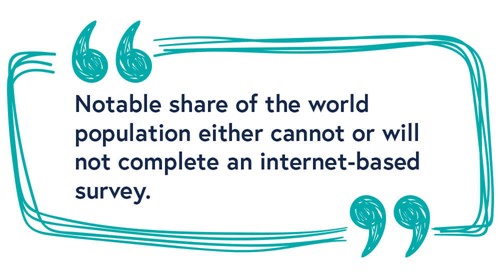
“Notable share of the world population either cannot or will not complete an internet-based survey,” says Pew Research.
Take an example. Think of yourself as a retail cloth merchant. You’ve both online and in-store customers. 80% of your revenue comes through in-store purchases. Where would you put the best bet? Gathering feedback from the store customers or the online visitors?
Of course, one with multiple resources has the luxury to survey all of their customers, online or offline, but you’d definitely want to learn the mood of your major buyers if asked to pick the one. And in this case, it’s the offline users that you want to target.
All this raises two crucial questions— whom do you miss with online surveys, and how does it affect your results?
Your sample frame matters. If you’re missing the essential population specifics from your survey, you will end up with the wrong data. Your biased survey-research will undermine the quality of data and hamper evidence-based decision-making in your business.
So, the question is— how do we minimize the risk of coverage error with the internet-based surveys? Well, we have an answer to it.
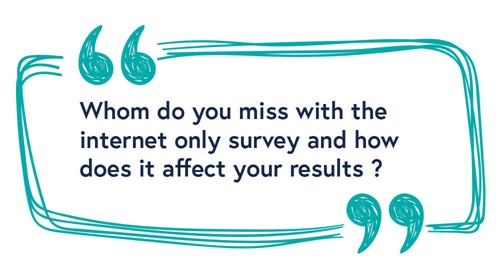
Offline surveys have found a new place in the form of apps that work without internet
Traditional surveys may have gotten out of date, but they now come with a modified and technical version where they stand out on merit with benefits that even online web surveys can’t offer.
In simpler words— you don’t have wifi connectivity? No problem. Offline survey apps will quickly help you in field surveys.
But there’s a lot more face-to-face survey apps offer, apart from quickly and securely collecting data without the internet connection. And that is— you get the absolute control over the participation specifics, and know if the chosen respondent is a part of your sample group.
Offline surveys on smartphones and tablets can reach where web-based surveys can’t. Here’s why you need it to complement online surveys.
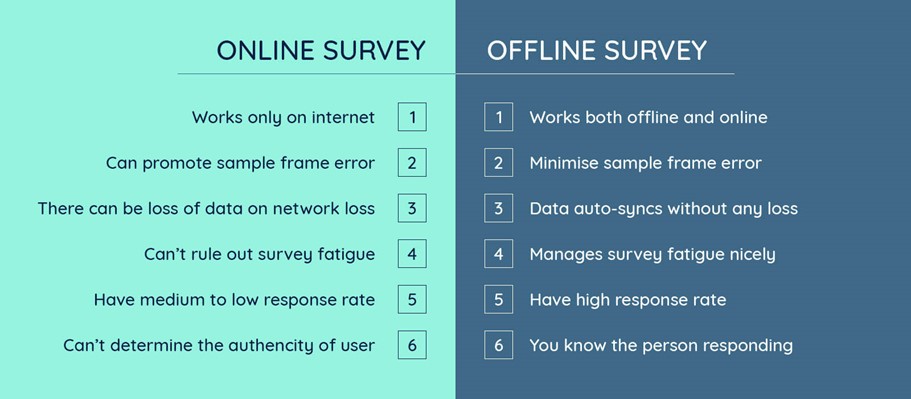
Advantage #1 Offline survey on mobiles are also the online survey apps
The best part about in-person offline mobile surveys is that they’re also online surveys. Yes, they’re internet-agnostic! How well does browsing youtube on offline mode feel like? Great, isn’t it? Precisely, the researchers feel with offline surveys.
Whether these surveys are connected or not, the offline survey tool captures and stores the data in real-time, and syncs all your field data when an active connection is paired.
You can use the offline mobile survey app to conduct web-based survey research too. Not all web-based survey apps have offline survey features. But all offline survey apps have the web-based feature.
Advantage #2 Helps in gathering in-person and remote evaluation.
We call offline survey apps the Swiss-army knife of survey methodologies. With plenty of features in it, you can collect data in-person or even any remote location.
If your sample frame doesn’t have the internet connection, you simply need to download the survey app on your phone or tablet and reach the location where you want to collect the responses. Market research in the wild or the alps, conduct your valuable face-to-face survey with a diversified advantage of the offline survey app.
Advantage #3 Minimizes sample frame error.
Does your survey sufficiently cover the population required for study? Not when you use web-based surveys. You are going to miss the ones who don’t have internet connectivity.
It leads to sampling frame error, which means you’re surveying (n minus m) numbers of respondents when you want to interview (n). A face-to-face offline survey minimizes the coverage error and allows you to conduct your research to your broader audience.
For example, the flaky network doesn’t allow you to collect responses from your customers in the mall. Result? Your bunch of un-pleased customers leaves without answering. Face-to-face offline surveys can help manage your data without waiting for the internet to show up.
Advantage #4 There’s no loss of data. Each response is safe and secure.
You might feel tempted to believe that your data might disappear in lingo while syncing with the database. But that’s not true. The offline app automatically syncs the responses of your users without any loss of data.
So, even if you’re collecting offline data, your data is safe and waiting for the internet connectivity to sync all of them automatically. It’s a kind of backup that a face-to-face survey app provides to have a smooth-feedback experience.
Advantage #5 You can run these surveys in kiosk booths.
Let’s be practical. You or your enumerators can’t be present everywhere. But you also want to have as many respondents as you can. Internet free survey apps can be useful in this case. They need not necessarily be face-to-face or in-person interviews. You can load offline questionnaires on kiosks and booths, even at places that don’t have internet connectivity.
It’s best when you’re orchestrating longitudinal studies and can’t be present at the site or gathering feedback from shoppers at the point of service. Lock your device in a kiosk, put your survey in auto-pilot, and have your answers ready without hovering around the respondents.
Advantage #6 It eliminates survey fatigue.
People are always skeptical when you request to complete your questionnaire. Ask yourself— why should anyone fill your survey forms? Your surveys discomfort some of them, some don’t care to respond at all, and sometimes— your surveys don’t give a hassle-free experience.
There’re plenty of let-downs when you’re on a field. Offline survey software eliminate survey fatigue and give your respondents enough reasons to complete without any inconveniences.
Advantage #7 Face-to-face offline survey tools are less annoying.
Non-engaging surveys are no less than poking your respondents. And no one likes getting poked. If your studies don’t take care of the feedback experience, your sample is likely to ignore or delete the survey without any hesitation.
But face-to-face offline surveys conducted under the guidance of your enumerator can clarify the probes and advocate more response.
Advantage #8 You’ll have a higher response rate.
What would you prefer? 90 out of 100 respondents responding or 500 out of 1000? A lot of respondents don’t participate in web-based surveys. They either feel uninterested, or your survey forms are too hard to understand, especially when there’s no one to guide around.
Even if you get a high response, participants are less likely to stay fully engaged for more than 5-7 minutes—part of the reason why many surveys are deserted.
But people are less likely to shut their doors on in-person survey apps because your presence matters. By creating engaging surveys with a smooth blend of close-ended and open-ended questions and required conditional logic, you can have a high response rate.
Advantage #9 You know the sample providing the answer is the right person.
How do you know who’s filling your online form? Is it your selected respondent, or is it his cousin? Unfortunately, it’s impossible to determine the authenticity of the respondents in web-based surveys. The quality of your data worsens off when one person fills your survey form twice or even thrice.
A face-to-face offline survey connects you with the sample directly, in the presence of your trained field data collector. It ensures that you have your samples identified without having to use identification verification tools.
Advantage #10 Fewer survey frauds and accurate data in the bag.
Surveys with redundant or long sets of questions might lead to survey frauds and invite fake answers. As with web-based surveys, chances of hitting the button just to have the promised reward at the end is too high. Such survey results are less accountable and will not contribute to your study accurately.
Face-to-face offline surveys can hardly attract survey fraud or fake answers as the tool equipped with offline functionality like GoSurvey comes with features like mobile OTP which helps in verifying the mobile number of respondent and also background audio recording which automatically records background audio from the start till the end of the survey and the surveyor or data collector won't even know about it. This makes sure that the survey is answered with the right prompts— without injecting any bias.
Right place, right time! The mightiest edge over web-based interviews.
When would you like to have responses the most? When your participants have the fresh experience with you or when they no longer remember you? As a thumb rule, certain surveys need to be taken right now and at the right place to extract rich data from their minds.
You’d be tempted to send online survey forms, but you may never hear from your customers. Face-to-face offline surveys make the most sense when you want to meet the participants right now.
- Want to have a quick survey response on your restaurant table? Ticked!
- Willing to hear out your customers in trade shows? Ticked!
- Looking forward to capturing leads in charity? Ticked!
- Looking to gather insight on the latest pandemic reports in rural areas? Ticked!
- Yearning to collect resources for your start-up? Ticked!
- Want to know the mood of the customers? Ticked!
- Longing to conduct field surveys at national parks? Ticked!
- Immediately looking to deploy surveys for exit polls? Ticked!
You think of a study, and offline surveys quickly and effortlessly allow you to design your questionnaire and deploy right there at the moment when it matters the most.
Common problems of online surveys— the issues that in-person offline surveys solve
Problem #1: Poorly chosen distribution channel skews or tampers the quality of data.
Problem #2: Survey fraud is the biggest challenge. Web-based surveys give no power over manipulated data.
Problem #3: You may never have access to non-customer samples with internet-based surveys.
Problem #4: Possible cooperation problems because your participants are interacting with a machine.
Problem #5: Data collection from all the locations is a distant dream.
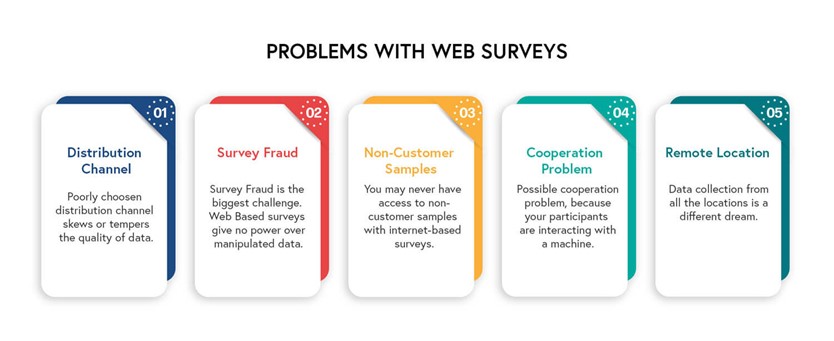
Here’s how face-to-face offline surveys resolve the matter.
Solution #1: In-person offline surveys allow you to cover the audience in low or no network areas. You can toggle them on as soon as you get the internet connectivity.
Solution #2: Under the guidance of interviewers, in-person offline surveys often go smooth and produce rich-full data.
Solution #3: Face-to-face offline surveys promote healthy field research in areas where you can’t access non-customer respondents.
Solution #4: Conducting a face-to-face offline field survey catches more eyeballs and creates a co-operating environment.
Solution #5: Think of a place on earth, and a face-to-face offline survey will capture your data and sync with the database as you connect with the internet.
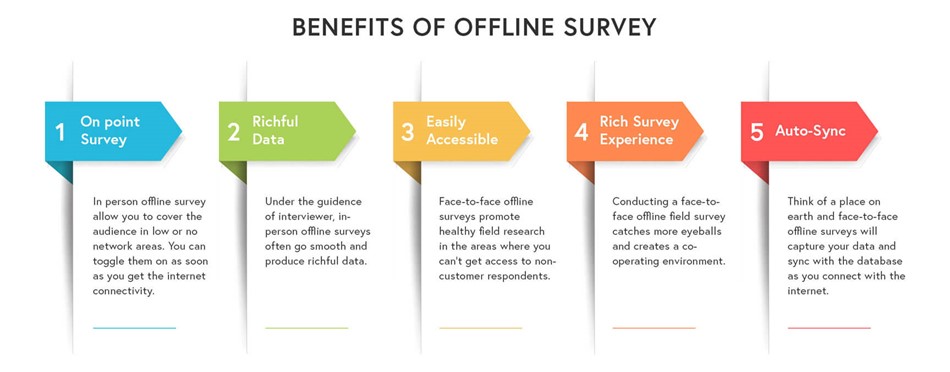
The workflow of the offline survey and online survey— the internet makes all the difference.
There’s one significant difference between the workflow of offline and online surveys— offline surveys will work irrespective of the internet. At the same time, the Online survey workflow has limitations. No Internet? Goodbye data.
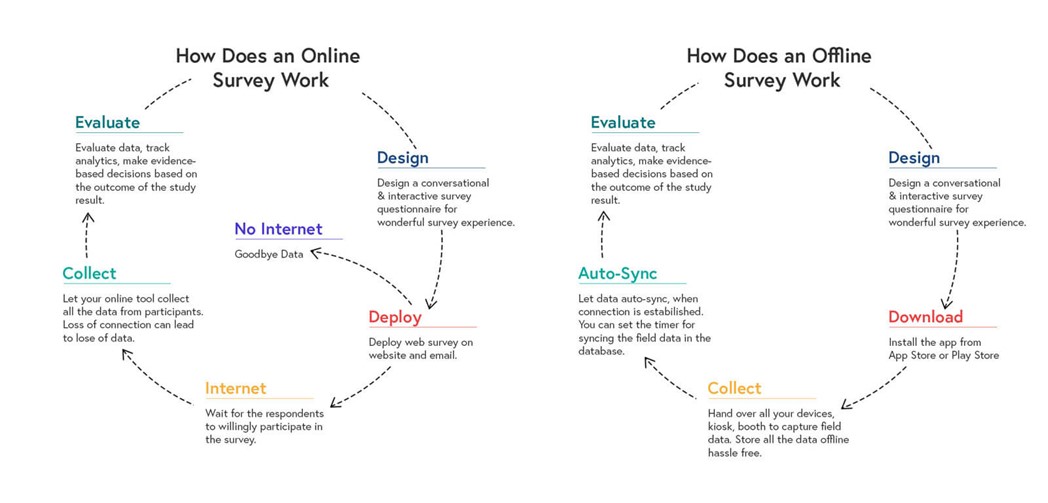
The conclusive argument— the key takeaways
Earlier, organizations either had to use paper or web-based surveys, or spend extra to fuse both the methodologies to reach their potential target specifications.
An internet free survey app picks the advantages of traditional and web-based surveys, and blends them together into a useful alternative that can meet your business and research objective.
Offline mobile apps have surely become one-tool-works-on-all survey solutions. With them you can achieve the following:
- No more reliance on the internet. Wifi or no wifi. Leave no stone untouched.
- Get better data at the faster rate. No more friction-full surveys. Collect data at ease.
- Turn on any mobile device into data-collecting station using the kiosk mode
- Protect all your customer’s data without having to worry about losing them.
- Gather data at large-scale. Reach audiences anywhere in the world.
- Use any device to collect data as offline survey supports multi-device compatibility features.
- Control a distributed channel of survey and prevent it from tampering.
- Timing is everything. Place your surveys exactly when you want fresh data from fresh mind-experiences.
- Program your survey design at your will and custom-tailor it based on the industrial requirements.
- Take rich data like images, locations, barcodes, timestamps, etc. from your customers and get visual understanding of data.






